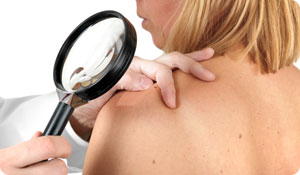
What's the difference between birthmarks, beauty marks, and moles?
Birthmarks are skin blemishes that form before you're born or shortly thereafter. Vascular ("strawberry") birthmarks tend to be areas of reddish, swelled skin thought to be caused by a non-harmful overgrowth of blood vessels. Moles can also occur as birthmarks, though most of us don't develop these until later. They're caused by a hyper-pigmentation of skin and are usually benign.
Beauty Marks are moles or birthmarks on the face, neck, or shoulder area. The term "beauty mark" has no medical basis; it comes from the historical idea that these are considered attractive.
Moles are the marks that should command your attention. You probably developed in-between 10 to 40 of these throughout childhood and adolescence. They can be raised or flat and come in a variety of colors. However, a change in a mole can be an early sign of melanoma, the skin cancer that kills more than 8000 Americans every year.
How do moles indicate melanoma?
The "tanning" cells in your skin - melanocytes - cluster and create moles. Melanoma tends to begin inside or next to moles. Since melanoma cells produce melanin, this leads to color and shape changes in your moles. By keeping an eye on them, you'll increase your chances of detecting a problem early. While melanoma can metastasize quickly, it's also 99% curable when detected early.
How can I track my moles?
Visit the American Academy of Dermatology's website to download a mole map you can use on a regular basis to track what your moles look like over time. Contact a dermatologist if you notice any of the following "ABCDE" changes in your moles:
- Asymmetry: One half looks different
- Border: Irregular or poorly defined outline
- Color: Various shading/colors
- Diameter: Larger than 4mm
- Evolving: The shape, size, or color has changed
The Skin Cancer foundation advocates an additional mole detection technique called the way to the "Ugly Duckling" method. This simply involves comparing each mole to the others on your body. The one that looks different could be an early sign of a lesion.
How do I know if I'm at risk?
The American Cancer Society details the following risk factors for melanoma:
- Family history of skin cancer like basal cell carcinoma or squamous cell carcinoma
- High number of moles - especially irregular and large ones - on your body
- Fair skin, light hair, and/or lots of freckles
- Compromised immune system
Should I have my mole removed?
There's no one answer to this question. If you think you should remove a mole - whether for medical or aesthetic reasons - the important first step is to talk to a dermatologist. You should never attempt to remove a mole on your own.
Sources:
American Academy of Dermatology
http://www.aad.org/public/publications/pamphlets/sun_skin.html
Skin Cancer Foundation
http://www.skincancer.org/Melanoma/
American Cancer Society
http://www.cancer.org/docroot/CRI/content/CRI_2_4_2X_What_are_the_risk_factors_for_melanoma_50.asp
American Academy of Dermatology site and mole map
http://www.melanomamonday.org/
http://www.melanomamonday.org/documents/08_96%20Melanoma%20Monday%20Mole%20Map.pdf





